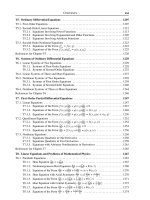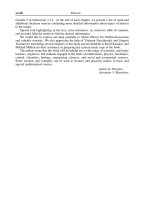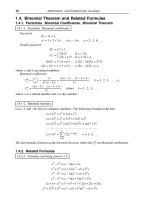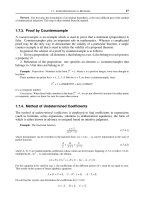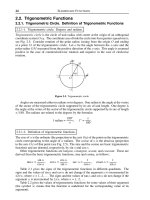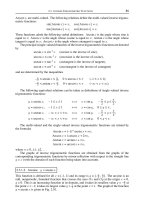Handbook of mathematics for engineers and scienteists part 52 potx
Bạn đang xem bản rút gọn của tài liệu. Xem và tải ngay bản đầy đủ của tài liệu tại đây (406.81 KB, 7 trang )
7.3. DOUBLE AND TRIPLE INTEGRALS 325
2. Additivity. If a domain U is split into two subdomains, U
1
and U
2
, that do not have
common internal points and if a function f(x, y, z) is integrable in either subdomain, then
U
f(x, y, z) dx dy dz =
U
1
f(x, y, z) dx dy dz +
U
2
f(x, y, z) dx dy dz.
3. Estimation theorem.Ifm ≤ f(x, y, z) ≤ M in a domain U,then
mV ≤
U
f(x, y, z) dx dy dz ≤ MV,
where V is the volume of U.
4. Mean value theorem.Iff(x, y, z) is continuous in U, then there exists at least one
internal point (¯x, ¯y, ¯z)
U such that
U
f(x, y, z) dx dy dz = f(¯x, ¯y, ¯z) V .
The number f(¯x, ¯y, ¯z) is called the mean value of the function f in the domain U.
5. Integration of inequalities.Ifϕ(x, y, z) ≤ f(x, y, z) ≤ g(x, y, z) in a domain U,then
U
ϕ(x, y, z) dx dy dz ≤
U
f(x, y, z) dx dy dz ≤
U
g(x, y, z) dx dy dz.
6. Absolute value theorem:
U
f(x, y, z) dx dy dz
≤
U
f(x, y, z)
dx dy dz.
7.3.5. Computation of the Triple Integral. Some Applications.
Iterated Integrals and Asymptotic Formulas
7.3.5-1. Use of iterated integrals.
1
◦
. Consider a three-dimensional body U bounded by a surface z = g(x, y) from above and
a surface z = h(x, y) from below, with a domain D being the projection of it onto the x, y
plane. In other words, the domain U is defined as {(x, y)
D : h(x, y) ≤ z ≤ g(x, y)}.Then
U
f(x, y, z) dx dy dz =
D
dx dy
g(x,y)
h(x,y)
f(x, y, z) dz.
2
◦
. If, under the same conditions as in Item 1
◦
, the domain D of the x, y plane is defined
as {a ≤ x ≤ b, y
1
(x) ≤ y ≤ y
2
(x)},then
U
f(x, y, z) dx dy dz =
b
a
dx
y
2
(x)
y
1
(x)
dy
g(x,y)
h(x,y)
f(x, y, z) dz.
326 INTEGRALS
7.3.5-2. Change of variables in the triple integral.
1
◦
.Letx = x(u, v, w), y = y(u, v, w), and z = z(u, v, w) be continuously differentiable
functions that map, one to one, a domain Ω of the u, v, w space into a domain U of the
x, y, z space, and let a function f(x, y, z) be continuous in U.Then
U
f(x, y, z) dx dy dz =
Ω
f
x(u, v, w), y(u, v, w), z(u, v, w)
|J(u, v, w)|du dv dw,
where J(u, v, w)istheJacobian of the mapping of Ω into U:
J(u, v, w)=
∂(x, y, z)
∂(u, v, w)
=
∂x
∂u
∂x
∂v
∂x
∂w
∂y
∂u
∂y
∂v
∂y
∂w
∂z
∂u
∂z
∂v
∂z
∂w
.
The expression in the middle is a very common notation for a Jacobian.
The absolute value of the Jacobian characterizes the expansion (or contraction) of an
infinitesimal volume element when passing from x, y, z to u, v, w.
2
◦
. The Jacobians of most common transformations in space are listed in Table 7.2.
TABLE 7.2
Common curvilinear coordinates in space and the respective Jacobians
Name of coordinates Transformation Jacobian, J
Cylindrical coordinates ρ, ϕ, z
x = ρ cos ϕ, y = ρ sin ϕ, z = z
ρ
Generalized cylindrical
coordinates ρ,ϕ, z
x = aρ cos ϕ, y = bρ sin ϕ, z = z abρ
Spherical coordinates r, ϕ, θ
x = r cos ϕ sin θ, y = r sin ϕ sin θ, z = r cos θ
r
2
sin θ
Generalized spherical
coordinates r, ϕ, θ
x = ar cos ϕ sin θ, y = br sinϕ sin θ,
z = cr cos θ
abcr
2
sin θ
Coordinates of prolate ellipsoid of
revolution σ, τ , ϕ (σ ≥ 1 ≥ τ ≥ –1)
x = a
(σ
2
– 1)(1 – τ
2
)cosϕ,
y = a
(σ
2
– 1)(1 – τ
2
)sinϕ,
z = aστ
a
3
(σ
2
– τ
2
)
Coordinates of oblate ellipsoid of
revolution σ, τ , ϕ (σ ≥ 0,–1 ≤ τ ≤ 1)
x = a
(1 + σ
2
)(1 – τ
2
)cosϕ,
y = a
(1 + σ
2
)(1 – τ
2
)sinϕ,
z = aστ
a
3
(σ
2
+ τ
2
)
Parabolic coordinates σ, τ , ϕ
x = στ cos ϕ, y = στ sin ϕ, z =
1
2
(τ
2
– σ
2
)
στ(σ
2
+ τ
2
)
Parabolic cylinder
coordinates σ, τ , z
x = στ, y =
1
2
(τ
2
– σ
2
), z = z
σ
2
+ τ
2
Bicylindrical coordinates σ, τ , z
x =
a sinh τ
cosh τ –cosσ
, y =
a sin σ
cosh τ –cosσ
, z = z
a
2
(cosh τ –cosσ)
2
Toroidal coordinates σ, τ , ϕ
(–π ≤ σ ≤ π, 0 ≤ τ < ∞, 0 ≤ ϕ < 2π)
x =
a sinh τ cos ϕ
cosh τ –cosσ
, y =
a sinh τ sin ϕ
cosh τ –cosσ
,
z =
a sin σ
cosh τ –cosσ
a
3
sinh τ
(cosh τ –cosσ)
2
Bipolar coordinates σ, τ , ϕ
(σ is any, 0 ≤ τ < π, 0 ≤ ϕ < 2π)
x =
a sin τ cos ϕ
cosh σ –cosτ
, y =
a sin τ sin ϕ
cosh σ –cosτ
,
z =
a sinh σ
cosh σ –cosτ
a
3
sin τ
(cosh σ –cosτ)
2
7.3. DOUBLE AND TRIPLE INTEGRALS 327
7.3.5-3. Differentiation of the triple integral with respect to a parameter.
Let the integrand function and the integration domain of a triple integral depend on a
parameter, t. The derivative of this integral with respect to t is expressed as
d
dt
U(t)
f(x, y, z, t) dx dy dz
=
U(t)
∂
∂t
f(x, y, z, t) dx dy dz +
S(t)
(n ⋅ v)f(x, y, z, t) ds,
where S(t) is the boundary of the domain U(t), n is the unit normal to S(t), and v is the
velocity of motion of the points of S(t).
7.3.5-4. Some geometric and physical applications of the triple integral.
1. Volume of a domain U:
V =
U
dx dy dz.
2. Mass of a body of variable density γ = γ(x, y, z) occupying a domain U:
m =
U
γdxdydz.
3. Coordinates of the center of mass:
x
c
=
1
m
U
xγ dx dy dz, y
c
=
1
m
U
yγ dx dy dz, z
c
=
1
m
U
zγ dx dy dz.
4. Moments of inertia about the coordinate axes:
I
x
=
U
ρ
2
yz
γdxdydz, I
y
=
U
ρ
2
xz
γdxdydz, I
z
=
U
ρ
2
xy
γdxdydz,
where ρ
2
yz
= y
2
+ z
2
, ρ
2
xz
= x
2
+ z
2
,and ρ
2
xy
= x
2
+ y
2
.
If the body is homogeneous, then γ = const.
Example. Given a bounded homogeneous elliptic cylinder,
x
2
a
2
+
y
2
b
2
= 1, 0 ≤ z ≤ h,
find its moment of inertia about the z-axis.
Using the generalized cylindrical coordinates (see the second row in Table 7.2), we obtain
I
x
= γ
U
(x
2
+ y
2
) dx dy dz = γ
h
0
2π
0
1
0
ρ
2
(a
2
cos
2
ϕ + b
2
sin
2
ϕ)abρdρdϕdz
=
1
4
abγ
h
0
2π
0
(a
2
cos
2
ϕ + b
2
sin
2
ϕ) dϕ dz =
1
4
abγ
2π
0
h
0
(a
2
cos
2
ϕ + b
2
sin
2
ϕ) dz dϕ
=
1
4
abhγ
2π
0
(a
2
cos
2
ϕ + b
2
sin
2
ϕ) dϕ =
1
4
ab(a
2
+ b
2
)hγ.
328 INTEGRALS
5. Potential of the gravitational field of a body U at a point (x, y, z):
Φ(x, y, z)=
U
γ(ξ, η, ζ)
dξ dη dζ
r
, r =
(x – ξ)
2
+(y – η)
2
+(z – ζ)
2
,
where γ = γ(ξ, η, ζ) is the body density. A material point of mass m is pulled by the
gravitating body U with a force
F . The projections of
F onto the x-, y-, and z-axes are
given by
F
x
= km
∂Φ
∂x
= km
U
γ(ξ, η, ζ)
ξ – x
r
3
dξ dη dζ,
F
y
= km
∂Φ
∂y
= km
U
γ(ξ, η, ζ)
η – y
r
3
dξ dη dζ,
F
z
= km
∂Φ
∂z
= km
U
γ(ξ, η, ζ)
ζ – z
r
3
dξ dη dζ,
where k is the gravitational constant.
7.3.5-5. Multiple integrals. Asymptotic formulas.
Multiple integrals in n variables of integration are an obvious generalization of double and
triple integrals.
1
◦
. Consider the Laplace-type multiple integral
I(λ)=
Ω
f(x)exp[λg(x)] dx,
where x = {x
1
, ,x
n
}, dx = dx
1
dx
n
, Ω is a bounded domain in R
n
, f(x)andg(x)
are real-valued functions of n variable, and λ is a real or complex parameter.
Denote by
S
ε
=
λ :arg|λ| ≤
π
2
– ε
, 0 < ε <
π
2
,
a sector in the complex plane of λ.
T
HEOREM 1.
Let the following conditions hold:
(1) the functions
f(x)
and
g(x)
are continuous in
Ω
,
(2) the maximum of
g(x)
is attained at only one point
x
0
Ω
(
x
0
is a nondegenerate
maximum point), and
(3) the function
g(x)
has continuous third derivatives in a neighborhood of
x
0
.
Then the following asymptotic formula holds as
λ →∞
,
λ S
ε
:
I(λ)=(2π)
n/2
exp[λg(x
0
)]
f(x
0
)+O(λ
–1
)
√
λ
n
det[g
x
i
x
j
(x
0
)]
,
where the
g
x
i
x
j
(x)
are entries of the matrix of the second derivatives of
g(x)
.
2
◦
. Consider the power Laplace multiple integral
I(λ)=
Ω
f(x)[g(x)]
λ
dx.
T
HEOREM 2.
Let
g(x)>0
and let the conditions of Theorem 1 hold. Then the following
asymptotic formula holds as
λ →∞
,
λ S
ε
:
I(λ)=(2π)
n/2
[g(x
0
)]
(2λ+n)/2
f(x
0
)+o(1)
√
λ
n
det[g
x
i
x
j
(x
0
)]
.
7.4. LINE AND SURFACE INTEGRALS 329
7.4. Line and Surface Integrals
7.4.1. Line Integral of the First Kind
7.4.1-1. Definition of the line integral of the first kind.
Let a function f(x, y, z)bedefi ned ona piecewise smooth curve
AB inthe three-dimensional
space R
3
.Letthecurve
AB be divided into n subcurves by points A = M
0
, M
1
, M
2
, ,
M
n
= B, thus defi ning a partition L
n
. The longest of the chords M
0
M
1
, M
1
M
2
, ,
M
n–1
M
n
is called the diameter of the partition L
n
and is denoted λ = λ(L
n
). Let us select
on each arc
M
i–1
M
i
an arbitrary point (x
i
, y
i
, z
i
), i = 1, 2, , n, and make up an integral
sum
s
n
=
n
i=1
f(x
i
, y
i
, z
i
) Δl
i
,
where Δl
i
is the length of
M
i–1
M
i
.
If there exists a finite limit of the sums s
n
as λ(L
n
) → 0 that depends on neither the
partition L
n
nor the selection of the points (x
i
, y
i
, z
i
), then it is called the line integral of
the first kind of the function f(x, y, z) over the curve
AB and is denoted
AB
f(x, y, z) dl = lim
λ→0
s
n
.
A line integral is also called a curvilinear integral or a path integral.
If the function f (x, y, z) is continuous, then the line integral exists. The line integral
of the first kind does not depend of the direction the path
AB is traced; its properties are
similar to those of the definite integral.
7.4.1-2. Computation of the line integral of the first kind.
1. If a plane curve is definedintheformy = y(x), with x [a, b], then
AB
f(x, y) dl =
b
a
f
x, y(x)
1 +(y
x
)
2
dx.
2. If a curve
AB is defined in parametric form by equations x = x(t), y = y(t), and
z = z(t), with t
[α, β], then
AB
f(x, y, z) dl =
β
α
f
x(t), y(t), z(t)
(x
t
)
2
+(y
t
)
2
+(z
t
)
2
dt.(7.4.1.1)
If a function f(x, y)isdefined on a plane curve x = x(t), y = y(t), with t
[α, β], one
should set z
t
= 0 in (7.4.1.1).
Example. Evaluate the integral
AB
xy dl,where
AB is a quarter of an ellipse with semiaxes a and b.
Let us write out the equations of the ellipse for the first quadrant in parametric form:
x = acos t, y = bsint (0 ≤ t ≤ π/2).
330 INTEGRALS
We have
(x
t
)
2
+(y
t
)
2
=
a
2
sin
2
t + b
2
cos
2
t. To evaluate the integral, we use formula (7.4.1.1) with
z
t
= 0:
AB
xy dl =
π/2
0
(a cos t)(b sin t)
a
2
sin
2
t + b
2
cos
2
tdt
=
ab
2
π/2
0
sin 2t
a
2
2
(1 –cos2t)+
b
2
2
(1 +cos2t) dt =
ab
4
1
–1
a
2
+ b
2
2
+
b
2
– a
2
2
zdz
=
ab
4
2
b
2
– a
2
2
3
a
2
+ b
2
2
+
b
2
– a
2
2
z
3/2
1
–1
=
ab
3
a
2
+ ab + b
2
a + b
.
7.4.1-3. Applications of the line integral of the first kind.
1. Length of a curve
AB:
L =
AB
dl.
2. Mass of a material curve
AB with a given line density γ = γ(x, y, z):
m =
AB
γdl.
3. Coordinates of the center of mass of a material curve
AB:
x
c
=
1
m
AB
xγ dl, y
c
=
1
m
AB
yγ dl, z
c
=
1
m
AB
zγ dl.
To a material line with uniform density there corresponds γ = const.
7.4.2. Line Integral of the Second Kind
7.4.2-1. Definition of the line integral of the second kind.
Let a vector field
a(x, y, z)=P (x, y, z)
i + Q(x, y, z)
j + R(x, y, z)
k
and a piecewise smooth curve
AB be defined in some domain in R
3
. By dividing the curve
by points A = M
0
, M
1
, M
2
, , M
n
= B into n subcurves, we obtain a partition L
n
.Let
us select on each arc
M
i–1
M
i
an arbitrary point (x
i
, y
i
, z
i
), i = 1, 2, , n, and make up a
sum of dot products
s
n
=
n
i=1
a(x
i
, y
i
, z
i
) ⋅
−−−−− →
M
i–1
M
i
,
called an integral sum.
If there exists a finite limit of the sums s
n
as λ(L
n
) → 0 that depends on neither the
partition L
n
nor the selection of the points (x
i
, y
i
, z
i
), then it is called the line integral of
the second kind of the vector field a(x, y, z) along the curve
AB and is denoted
AB
a ⋅ dr,or
AB
Pdx+ Qdy+ Rdz.
7.4. LINE AND SURFACE INTEGRALS 331
The line integral of the second kind depends on the direction the path is traced, so that
AB
a ⋅ dr =–
BA
a ⋅ dr.
A line integral over a closed contour C is called a closed path integral (or a circulation)
of a vector field a around C and is denoted
C
a ⋅ dr.
Physical meaning of the line integral of the second kind:
AB
a ⋅ dr determines the
work done by the vector field a(x, y, z) on a particle of unit mass when it travels along the
arc
AB.
7.4.2-2. Computation of the line integral of the second kind.
1
◦
. For a plane curve
AB defined as y = y(x), with x [a, b], and a plane vector field a,
we have
AB
a ⋅ dr =
b
a
P
x, y(x)
+ Q
x, y(x)
y
x
(x)
dx.
2
◦
.Let
AB be defined by a vector equation r =r(t)=x(t)
i + y(t)
j + z(t)
k, with t [α, β].
Then
AB
a ⋅ dr =
AB
Pdx+ Qdy+ Rdz
=
β
α
P
x(t), y(t), z(t)
x
t
(t)+Q
x(t), y(t), z(t)
y
t
(t)+R
x(t), y(t), z(t)
z
t
(t)
dt.(7.4.2.1)
For a plane curve
AB and a plane vector field a, one should set z
(t)=0 in (7.4.2.1).
7.4.2-3. Potential and curl of a vector field.
1
◦
. A vector field a = a(x, y, z) is called potential if there exists a function Φ(x, y, z)such
that
a =gradΦ,ora =
∂Φ
∂x
i +
∂Φ
∂y
j +
∂Φ
∂z
k.
The function Φ(x, y, z) is called a potential of the vector field a. The line integral of the
second kind of a potential vector field along a path
AB is equal to the increment of the
potential along the path:
AB
a ⋅ dr = Φ
B
– Φ
A
.
2
◦
.Thecurl of a vector field a(x, y, z)=P
i + Q
j + R
k is the vector defined as
curla =
∂R
∂y
–
∂Q
∂z
i +
∂P
∂z
–
∂R
∂x
j +
∂Q
∂x
–
∂P
∂y
k =
i
j
k
∂
∂x
∂
∂y
∂
∂z
PQR
.
The vector curla characterizes the rate of rotation of a and can also be described as the
circulation density of a. Alternative notations: curl a ≡∇× a ≡ rota.



